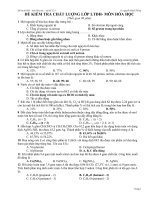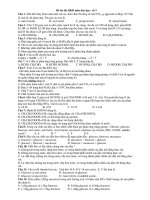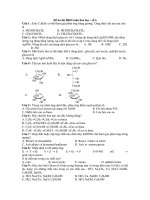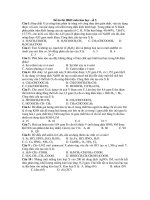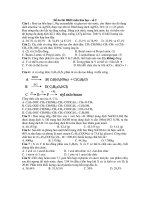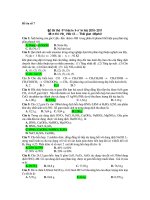Đề ôn thi thử môn hóa (708)
Bạn đang xem bản rút gọn của tài liệu. Xem và tải ngay bản đầy đủ của tài liệu tại đây (177.12 KB, 5 trang )
ee3
Abstract: Neuroimaging is critical to the diagnosis and management of many children in the intensive care unit (ICU). The most
appropriate type of imaging study to perform will depend on
the clinical situation. Close consultation with radiologists will
improve selection and interpretation of imaging studies. This
chapter reviews the fundamentals of neuroimaging techniques
and presents imaging examples of conditions seen in the ICU.
Key words: neuroimaging, computed tomography (CT), magnetic resonance imaging (MRI), ultrasound, angiography, stroke,
hemorrhage, demyelination, hydrocephalus
62
Coma and Depressed Sensorium
NEETHI PINTO AND CASEY STULCE
PEARLS
• Coma is a state of unconsciousness with lack of awareness and
loss of wakefulness.
• A Glasgow Coma Scale score of less than 15 in children should
be taken seriously.
• Arousal may be depressed by either direct brainstem injury involving the reticular formation or bilateral cerebral hemispheric
dysfunction.
• The ABCs (airway, breathing, and circulation) should be prioritized during management of a comatose child. When in doubt,
it is better to protect the airway in order to prevent hypoxemia
and hypercarbia.
• Early measurement of blood glucose is important during initial
stabilization of a comatose child.
• Abnormal pupillary reflexes and/or altered respirations may be
signs of impending herniation.
• The goal of therapy should be the prevention of secondary
brain injury.
• A combination of physical signs, electroencephalography, somatosensory evoked potentials, and magnetic resonance imaging can be helpful in predicting outcomes.
Coma refers to injury and impaired function of the brain due to
structural central nervous system (CNS) and/or metabolic or
systemic etiologies. Coma may result from traumatic or nontraumatic brain injury; it is a life-threatening medical emergency
prompting immediate methodical evaluation and treatment. If
not recognized and evaluated, secondary injury with resultant
morbidity and mortality may occur. Conversely, rapid treatment
may improve prognosis.1
hallucinations; states of reduced alertness include lethargy, obtundation, and stupor. Lethargy refers to drowsiness or decreased
wakefulness but with a preserved ability to communicate when
appropriately stimulated. Obtundation refers to a deeper state of
unresponsiveness, with loss of ability to respond to vigorous stimuli. Stupor refers to decreased responsiveness with arousability only
to noxious stimuli. The subjective, examiner-dependent nature of
these states and lack of uniformity in their definitions in the literature are problematic, rendering these terms less useful as specific
descriptors of altered consciousness.1,3 Rather, the use of validated
coma scales to gauge level of consciousness (LOC) allows for improved objectivity and uniformity in describing states of altered
consciousness. Ideally, these scales would have interrater reliability,
ease of administration, applicability to both a wide range of ages
and a variety of clinical scenarios resulting in altered consciousness,
and an ability to differentiate levels of coma requiring intervention.4
Among the available instruments, the Glasgow Coma Scale
(GCS) score is the most commonly used and widely accepted
(Table 62.2).4–6 The GCS focuses on assessment of cortical
function in three areas (motor response, verbal performance, and
eye opening) and has been modified for use in children and infants.4,7,8 Total scores range from 3 to 15, with categorization of
scores from 3 to 8, 9 to 12, and 13 to 15, reflecting severe, moderate, and mild injury, respectively.
Definitions
Consciousness is a spontaneous state of awareness of self and environment and wakefulness. Coma is a pathologic state of unconsciousness, with lack of awareness of self and environment and
loss of wakefulness. Unlike states of transient unconsciousness,
such as syncope and concussion, coma is a sustained state that
requires the duration of unconsciousness to be at least 1 hour.
Comatose patients present with their eyes closed; coma is distinct
from normal sleep due to its deep unarousable state.1,2
Coma may result in a spectrum of outcomes ranging from recovery to brain death. In between recovery and brain death are
other disorders, including locked-in state, minimally conscious
state, and the persistent vegetative state (Table 62.1). As noted in
these other states of disordered consciousness, awareness requires
wakefulness, but wakefulness (with intact sleep-wake cycles) does
not require awareness.2
Aside from these altered states of consciousness, other terms
are used to describe alterations in mental status that reference
states of heightened or reduced alertness. States of heightened
alertness include delirium (see Chapter 134), delusions, and
756
Epidemiology
Estimating the incidence of pediatric coma is complicated by the
fact that studies use different criteria for severity of brain injury.
Typically, studies of traumatic brain injury (TBI) include patients
757
CHAPTER 62 Coma and Depressed Sensorium
TABLE
Disorders of Consciousness and Other Conditions
62.1
Condition
Awareness
Wakefulness
Physical Exam
Outcome
Brain death
Absent
Absent
No reflexes or only spinal reflexes
Absent respiratory function
No recovery
Coma
Absent
Absent
No purposeful movement
Variably depressed respiratory effort
Death, persistent vegetative
state, or recovery by 4 wk
Persistent vegetative state
Absent
Intact
No purposeful movement
Normal respiratory effort
Dependent on etiology
Minimally conscious state
Very limited
Intact
Severe limitation of movement
Variably depressed respiratory effort
Recovery unknown
Locked-in syndrome
Present
Intact
Quadriplegia, pseudobulbar palsy; eye movements preserved
Normal to variably depressed respiratory effort
Recovery unlikely
Modified from Ashwal S. Medical aspects of the minimally conscious state in children. Brain Dev. 2003;25(8):535–545.
TABLE
Glasgow Coma Scale Scoring With Modification for Infants and Children
62.2
Activity
Infant
Child
Adult
Score
Motor response
Moves spontaneously, purposely
Withdraws to touch
Withdraws to pain
Decorticate posturing to pain
Decerebrate posturing
None
Obeys commands, spontaneous movements
Localizes pain
Withdraws to pain
Flexion in response to pain
Extension in response to pain
None
Follows commands
Localizes pain
Withdraws to pain
Flexion in response to pain
Extension in response to pain
None
6
5
4
3
2
1
Verbal response
Coos and babbles
Irritable, cries
Cries in response to pain
Moans in response to pain
None
Age-appropriate, oriented, smiles
Confused, aware of environment
Irritable, inconsistently consolable
Inconsolable, unaware of environment, agitated
None
Oriented
Confused
Inappropriate words
Nonspecific sounds
None
5
4
3
2
1
Eye opening
Spontaneous
To sound
To pain
None
Spontaneous
To sound
To pain
None
Spontaneous
To sound
To pain
None
4
3
2
1
Data from Kirkham FJ, Newton CR, Whitehouse W. Paediatric coma scales. Developmental Medicine & Child Neurology 2008;50:267–274; Wong CP, Tay EL. Childhood brain injury: a review. Neurol
Asia. 2015;20:105–115.
with GCS scores less than 12, whereas studies of nontraumatic
brain injury include patients with GCS scores less than 8.8
With these criteria in mind, the incidence of pediatric TBI (see
Chapter 118) ranges from 765 per 100,000 children aged 0 to
15 years to 1188 per 100,000 children aged 0 to 4 years,8-10 but
traumatic and nontraumatic coma appear to have approximately
equal incidences of 30 per 100,000 children.3,11 Notably, the incidence of nontraumatic pediatric coma is highest among infants,
with 160 per 100,000 children age 0 to 1 years affected.11
Relevance
As a medical emergency, coma presents a challenge to intensivists
because optimal care requires timely intervention. However,
information is frequently limited during the initial evaluation.
Assessment of LOC and knowledge of CNS anatomy and physiology may provide helpful clues in attempting to interpret patient
history and physical findings and optimize care. A careful general
physical examination with a focused neurologic examination can
suggest the diagnosis, aid in the location of lesions, guide therapeutic
intervention, and determine prognosis. Further adjunctive radiologic and laboratory evaluation may then confirm physical findings.
A timely, methodical approach to the management of the comatose
child may affect prognosis and long-term outcomes. Therefore, this
chapter considers CNS anatomy, the pathophysiology of coma,
historical and physical findings that aid in the localization of lesions
and the etiology of coma, the emergent management and initial
evaluation of patients with altered levels of consciousness, and the
prognosis and outcomes of patients who present with coma.
Physiology/Pathophysiology
Arousal is mediated by the ascending reticular activating system
(ARAS). The ARAS is principally located in the brainstem in the
paramedian tegmental gray matter immediately ventral to the
pons (Fig. 62.1). The ARAS is composed of two distinct anatomic
pathways. The first pathway consists of cholinergic neurons
originating in the pedunculopontine tegmental and laterodorsal
758
S E C T I O N V I Pediatric Critical Care: Neurologic
• BOX 62.1 Etiologies of Impaired Consciousness
and Coma
Cerebral cortex
Metabolic-Toxic
Hypoxia-Ischemia
Cerebellum
Thalamus
Subthalamus and
hypothalamus
Midbrain Pons Bulb
Ascending reticular
activating system
in brainstem
Afferent
collaterals
• Fig. 62.1 Ascending
reticular activating system (ARAS). The ARAS is
principally located in the brainstem and is composed of two distinct anatomic pathways. These pathways mediate arousal through projections to
the thalamus and cortex.
12
Industrial toxins (e.g., heavy metals,
organic phosphate, cyanide,
volatile hydrocarbons)
Substance abuse (e.g., alcohol,
cocaine, heroin, amphetamine)
Shock
Cardiac or pulmonary failure
Near drowning
Carbon monoxide poisoning
Strangulation
Poisoning, Including in Cases of
Munchausen by Proxy
Metabolic Disorders
Infection
Hypoglycemia
Acidosis
Diabetic ketoacidosis
Organic and aminoacidemias
Hyperammonemia
Hepatic encephalopathy
Reye syndrome
Urea cycle disorder
Disorders of fatty acid metabolism
Valproic acid encephalopathy
Uremia
Bacterial
Viral
Rickettsial
Paroxysmal Disorders
Epilepsy
Migraine
Structural-Intrinsic
Trauma
Dehydration
Hyponatremia
Calcium and magnesium imbalance
Concussion
Cerebral contusion
Epidural hematoma
Subdural hematoma/effusion
Intracerebral hematoma
Diffuse axonal injury
Endocrine Disorders
Neoplasms
Fluid and Electrolyte Imbalance
Thyroid dysfunction
Adrenal insufficiency
Hypoparathyroidism
tegmental nuclei of the mesopontine tegmentum. These cholinergic neurons send excitatory signals through the thalamus to the
cortex. The second pathway consists of noradrenergic and serotonergic neurons originating in the upper brainstem and caudal
hypothalamus. This second pathway bypasses the thalamus and
activates neurons in the lateral hypothalamic area, basal forebrain,
and cerebral cortex. This second pathway includes the locus coeruleus, the periaqueductal gray matter, and the raphe nuclei.12
Because the ARAS receives collaterals from and is stimulated
by every major somatic and sensory pathway directly or indirectly,
it is best regarded as a physiologic rather than an anatomic entity.
This partly explains why patients with very large discrete lesions
(e.g., brain tumors) may be entirely alert, whereas patients with
anatomically undetectable but biochemically widespread lesions
(e.g., hepatic encephalopathy) may be deeply comatose. Primarily,
two types of lesions depress the level of arousal: direct brainstem–
diencephalic injury involving the reticular formation and nuclei
or bilateral cerebral hemisphere dysfunction. Consequently, conscious behavior depends on the interplay between the cerebral
cortex and the ARAS because these neural components are required for arousal and to maintain awareness.13,14
The differential diagnosis is age related (Table 62.3). Hypoxemia and ischemia/reperfusion injury are important causes of
coma in all ages of pediatric patients. These entities are thoroughly discussed in Chapter 62.
Etiology
Initial Treatment of the Comatose Child
Coma is a nonspecific consequence of various CNS insults.3 Coma
may present as part of the progression of a known illness, as an
unpredictable consequence of a known systemic disease, or as a
result of a totally unexpected event or illness.15 As discussed earlier,
unilateral cortical lesions do not typically cause coma because the
ARAS is widely distributed in the cortical region. However, a small
brainstem lesion can cause immediate coma because of the close
proximity to the ARAS. Lesions in the brainstem may be due to
demyelinating diseases, vascular disease, neoplasm, or head trauma.
Common etiologies of coma in the pediatric population include
metabolic, toxic, structural, and intrinsic causes (Box 62.1).
The approach to the comatose child necessitates immediate, ongoing resuscitation while simultaneously undertaking elements of
the physical examination, seeking historical details, and initiating
diagnostic evaluation.
Hypertensive Encephalopathy
Vitamin Deficiency
Thiamine
Pyridoxine
Niacin
Mitochondrial Disorders
Exogenous Toxins and Poisons
Narcotics, neuroleptics, antidepressants,
antiepileptic drugs, stimulants
Over-the-counter drugs,
acetaminophen, mushrooms
Vascular Disease
Cerebral infarction
Thrombosis, embolism
Cerebral hemorrhage
Arteriovenous malformation
Aneurysm
Vasculitis
Trauma to carotid or vertebral artery
in the neck
Focal Infection
Cerebritis
Abscess
Hydrocephalus
Prehospital Care
Survival and outcome depend on delivery of high-quality care as
soon as possible after injury. Recommendations for prehospital
trauma life support follow.1,16
1. Airway: Endotracheal intubation if GCS is 8 or less
CHAPTER 62 Coma and Depressed Sensorium
TABLE Common Considerations of Altered Mental
62.3
Status at Various Ages
Infant
Child
Adolescent
Infection
Ingestion
Ingestion
Inborn error of metabolism
Infection
Trauma
Metabolic
Trauma, including
inflicted
Infection
Trauma, including inflicted
Metabolic
Psychological
Congenital abnormality
Seizure
Seizure
Hypoxic ischemic injury
Hypoxic ischemic
injury
Hypoxic ischemic
injury
Intussusception
2. Breathing: Maintaining adequate oxygenation and normal
ventilation
3. Circulation: Control of external hemorrhage and intravenous
fluid resuscitation to maintain systolic blood pressure appropriate for age
4. Assessment of blood glucose levels
5. Cervical spine precautions
6. Recognition and treatment of increased intracranial pressure
(ICP; see Chapter 63)
7. Treatment of seizures (see Chapter 64)
8. Safe transportation to a pediatric hospital with a high-level
trauma center and neuroimaging and neurosurgical capacity if
due to TBI
Initial Stabilization
Upon arrival to the hospital setting, continued attention to airway, breathing, and circulation are paramount in the initial management and stabilization of the comatose child to ensure adequate oxygenation, ventilation, and tissue perfusion. Cervical
spine injury and increased ICP should be suspected in comatose
patients with TBI. Compared with other organs, metabolic activity
in the brain is relatively high. The brain has little capacity to store
glucose and accordingly depends on constant delivery of energy
substrate and oxygen to maintain normal metabolic function.
Early management of blood glucose and appropriate treatment of
hypoglycemia is crucial to treatment and prevention of secondary
injury. Comatose patients often are hypercapnic and hypoxemic.
Thus, supplemental oxygen should be provided to the patient
with hypoxia during the initial evaluation.
Airway
Upper airway obstruction as a result of decreased muscle tone
of the pharyngeal soft tissue is a common problem in unresponsive patients, necessitating endotracheal intubation for
airway protection. It also is common practice to endotracheally intubate patients with hemodynamic instability or neurologic instability. In most circumstances, it is safer to endotracheally intubate electively rather than emergently to protect an
already compromised brain from further injury as a result of
respiratory failure. Endotracheal intubation (if not already
done prior to hospital arrival) should be performed if the GCS
is 8 or less.
759
Hyperextension of the neck must be avoided during intubation. Rapid sequence intubation should be performed with careful selection of medications in order to avoid agents that may
worsen intracranial hypertension and caution with the dosage of
medication (e.g., benzodiazepines and barbiturates) to prevent
compromise of mean arterial pressure and cerebral perfusion pressure. During endotracheal intubation, special precautions should
be taken to protect cerebral circulation and prevent further increases in ICP. Pretreatment with lidocaine and thiopental may
help to diminish elevation in ICP associated with airway manipulation and suctioning.
After intubation, careful attention to endotracheal tube
position and suctioning of oropharyngeal secretions is warranted. Once the patient’s airway is secured, adequacy of oxygenation and ventilation must be maintained by choosing
appropriate ventilator settings and evaluating respiratory effort, continuous pulse oximetry, and end-tidal carbon dioxide
monitoring.
Breathing
Hyperventilation may facilitate reduction in ICP or hypercarbia due to hypoventilation from altered mental status (e.g., in
the setting of intoxication). However, it is also important to
maintain Paco2 between 35 and 40 mm Hg in order to avoid
rapid fluctuations in cerebral blood flow from cerebral vasoconstriction (seen with excessive hyperventilation) and exacerbation of secondary injury. An exception is in cases of brain
herniation, where hyperventilation is often the most expeditious intervention. As noted in the patient’s initial stabilization, continued prevention of hypoxia is essential to maintaining normal metabolic function and prevention of secondary
brain injury.
Circulation
Rapid assessment of circulation and tissue perfusion—including evaluation of central and peripheral pulses, capillary refill,
and blood pressure—is important. Hypotension must be corrected to reestablish adequate cerebral blood flow to ensure
oxygen and substrate delivery. Once hypotension is corrected,
some evidence indicates that blood pressure should be maintained higher than the 75th percentile for age to maintain adequate cerebral perfusion pressure pending placement of ICP
monitoring equipment.17
Vascular access may prove challenging—timely placement of
intraosseous access must be considered. Aggressive fluid resuscitation with isotonic fluids to restore normal circulatory status
may be necessary. Hypotonic fluids are not indicated and may
exacerbate cerebral edema. Management of blood pressure depends on suspected etiology of the comatose state. On the one
hand, maintenance of mean arterial pressure is necessary to ensure adequacy of cerebral perfusion pressure if increased ICP is
suspected. On the other hand, in cases of hypertensive encephalopathy or intracranial hemorrhage, judicious correction and/or
prevention of hypertension may be warranted.
History
Given the need to evaluate and treat the comatose child emergently, an abbreviated but targeted interview of the child’s parents
or caregivers can provide insight into the etiology of the coma.
Important elements to elicit from the history, which may elucidate the cause of the coma, include the following.

